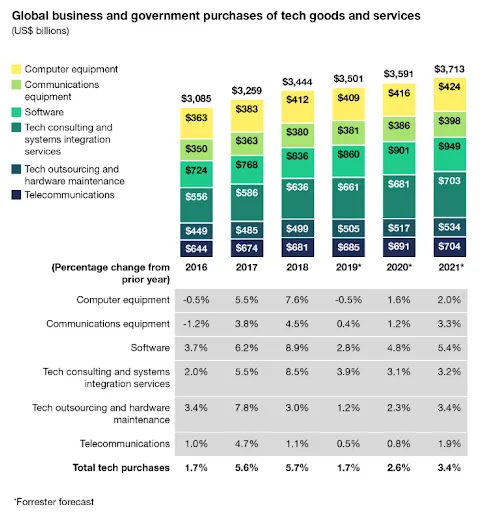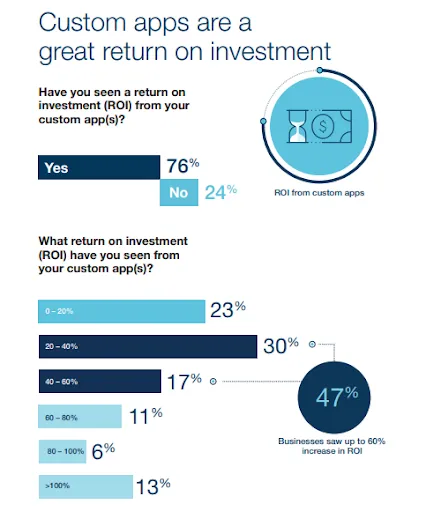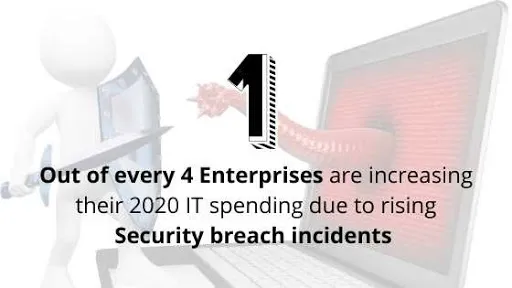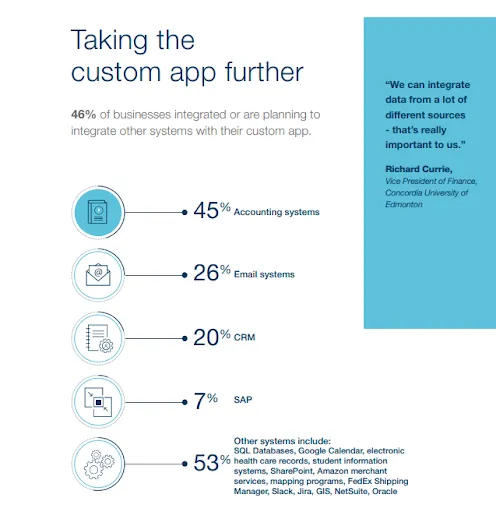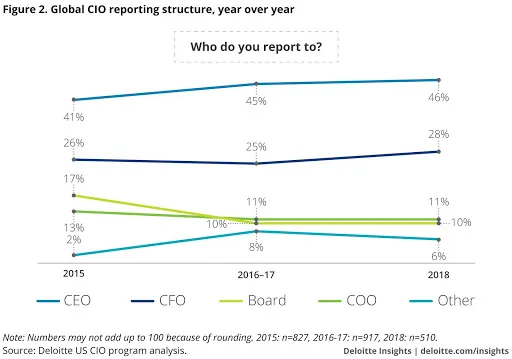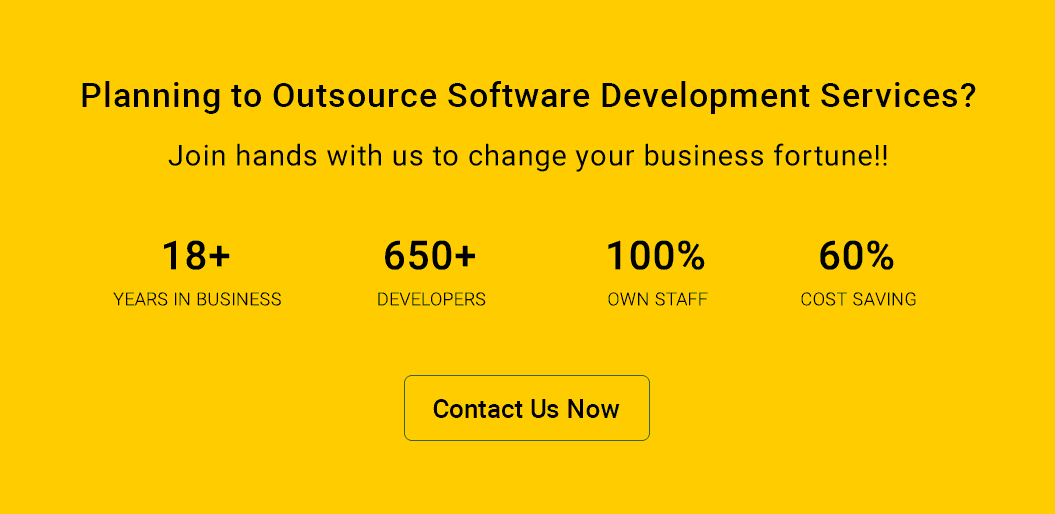The ever-changing dynamics of the economy and technology make it hard for a CIO to meet existing enterprise demands while trying to be innovative simultaneously.
This especially applies to the usage of technology in an enterprise, where leaders desire to leverage software technology to bring improvements in efficiency and performance to their businesses.
Say, an enterprise using conventional centralised technologies to record and maintain data is suddenly met by a demand to use new technology such as blockchain for the same.
In such a case, the need for using new technology will be more out of the fear of lagging behind in the latest technology trends, rather than out of necessity.
There are several problems such as these that create challenges in Enterprise software development. The need for seamlessly integrated enterprise software is gradually increasing as enterprises delve deeper into understanding demands at a deeper level and attempt to solve problems rarely thought about.
There is a good reason why the enterprise software industry is expected to grow by up to 10.5% in 2020, and why it is the fastest-growing segment in the entire IT industry. With new advancements and emerging technologies coming into play, enterprises have begun to realize that human capital simply isn’t enough.
If you need evidence for the same, have a look at the chart below.
Forrester Research forecasts show that Global businesses and Governments are investing heavily in Enterprise-grade Software, Tech Consulting, and Systems Integration services. Source: Global Tech Market Outlook For
The above charts show investments in tech goods and services between the years 2016- 2021. Notice something here? Investments in Enterprise Software, Tech Consulting & Systems Integration Services have increased at the highest rates since 2018. Predictions from Forrester Research echo my points- businesses are increasingly relying on technology consulting and software to enhance business processes and adapt to the modern information era.
To solve the new-age issues, businesses require enterprise systems that get routine work done in an instant, help allocate work and allot time to objectives that meet the goal of profitability and sustainability.
Enterprise software development in the present day is about finding problems nobody thought of before, and creating solutions using technologies and its integrations that remove all boundaries and seamlessly integrate all functions across an enterprise.
But just like one challenge I mentioned above, there are several other challenges on the road to enterprise software development that most CIOs fail to see, or just decide to hit the iceberg despite having seen it from miles ahead.
Discover how ValueCoders can help CIOs overcome software development hurdles.
1. Creating an immersive Enterprise App without affecting Costs & ROI
(The above video shows how Boeing is using AR to create an immersive software application for technician training)
Consumer Apps of the modern-day are all about enticing customers into using apps with immersive UI that deliver experiences users simply wouldn’t want to get out of. A right swipe on a smartphone app is just a navigation gesture used to enable specific functions. But it means so much more than that on an app like Tinder.
While enterprise apps don’t need such levels of form-over-function approach as in the case of consumer-oriented apps, there is a growing demand for features that make the task of using such apps engaging.
Navigating through an off-the-shelf ATS (Applicant Tracking Software) software that gives you bland notifications on suitable job candidates can get boring after a time. But adding a human element to it, say with a hyperactive AI bot that provides such information in a conversational way changes the entire experience.
But can immersive experiences with enterprise software justify the costs potentially incurred to add such features?
Not in the short term, but definitely in the longer run. A one-time focus on creating a seamlessly integrated design of the entire systems ecosystem adds to the enterprise value.
If an employee is used to operating one enterprise system software (which has an immersive, engaging UX) for their job-related purposes, they’ll find it much easier to adapt to other enterprise software that’s part of the organization ecosystem.
This fact is already proven in the realm of consumer software and apps. If you use an Apple iPhone, you’ll likely find it easier to navigate through other Apple devices such as an iPad or a MacBook. If you use an office application suite such as the Google G Suite or Microsoft Office 365, then you’d know how easy it is to recognize, understand and navigate through their individual apps owing to the familiarity in them.
This practice of making users addicted to an ecosystem works so well that a Forrester report estimated revenue generation of $100 for every $1 spent on UX in consumer-focused apps!
But enterprise software is an entirely different ball game where each feature, each addition is meant to enhance productivity and increase efficiency rather than entice its users, i.e., those working for the enterprise.
That is why things are a bit rough if you consider increasing costs to build immersive experiences in enterprise software. Increasing costs is only justified if a new design approach helps in achieving certain objectives.
There are some great examples of enterprises that have managed to do this.
Take for instance, how Boeing achieved a 40 percent increase in productivity by using AR for providing electrical installation training to employees. Or how Walmart increased its employee retention rates by 10% after introducing VR-powered employee training programs.
By leveraging AR and VR into their employee training software ecosystem, these two companies (Boeing & Walmart) highlight how investing in an immersive enterprise application using emerging technologies can justify costs involved and result in significant ROI at the same time.
2. Understanding the long-run approach
Surveys such as those done by Apple’s subsidiary FileMaker suggest that enterprises are witnessing increased ROI from their custom apps
As I have mentioned before, enterprise systems and software are particularly meant to enhance organizational productivity and performance across the entire internal business environment. But obviously, it is an expense, and expenses need to be recovered sooner or later.
In the case of Enterprise Software, getting any ROI out of the project is only possible in the long-term. That’s because their benefits do not take shape immediately after deployment. They take time. In fact, an enterprise may require further investments to train employees on using the new software, especially if the software is integrated across multiple departments of the organization.
But if the market trends are any indication, most enterprise software is likely to generate decent ROI in the longer run. Market research by FileMaker (a subsidiary of Apple) in the years 2016 and 2018 revealed an interesting trend.
In its research in the year 2016, over 60 percent of enterprises reported positive ROI after investing in custom enterprise software.
In 2018, the percentage increased to 76% with enterprises reporting significant ROI after integrating custom software across their business line.
The fact that enterprises are able to justify their expenses on custom enterprise software is surprising given the fact that custom software development is generally an expensive affair as compared to using off-the-shelf software.
This brings me to define another challenge in Enterprise Software Development, which is…
3. Choosing between Custom Enterprise Software Vs. Off-the-Shelf Software
Information Source: Spiceworks State of IT report- 2020
Off-the-shelf software is a highly convenient solution for CIOs aiming to solve a few inefficiencies and integrate a few functions using enterprise software. However, they come with their own share of drawbacks too.
- Firstly, off-the-shelf software may come with a lot of redundant features that may never be used by an organization.
- Second, a business using off-the-shelf enterprise software has to formulate its functions centered around the software instead of the other way around.
I have seen some enterprises fall victim to the second drawback I just mentioned. One firm I worked with had to design their entire employee attendance policies around an off-the-shelf attendance tracking software! That happened only because they weren’t able to customize the software configuration as per their policies.
Sure, some off-the-shelf enterprise software comes with heavy customization capabilities, but those only add up to the size they take and consequently require more hardware resources to perform at the optimum level.
On the other hand, there are certain advantages when using custom enterprise software:
- With custom enterprise software, an organization can add and deploy only the required features and build the enterprise system centered around the internal business environment.
- A custom enterprise software’s biggest advantage I feel is in terms of security. Every popular off-the-shelf enterprise software is used by hundreds of companies. So if a security vulnerability is exploited on one installation, it could potentially put all enterprise systems using the software at risk!
A custom enterprise software could be as unique as it gets, gives the enterprise a solid security foundation while keeping it secure from contagious security attacks as they happen with off-the-shelf software.
The main drawbacks of custom enterprise systems come in the form of the costs involved in software development, as well as the time it takes to build, test and deploy the final product.
Regardless of whether you choose to work with an off-the-shelf application or a custom enterprise software, there is one challenge in development that requires support outside the IT realm.
Dive into the critical challenges that can impact your projects.
4. Synchronization between Operational Units and IT
FileMaker’s State of the Custom App report suggests findings that 46% of businesses are looking forward to integrate other systems with their enterprise software
In research conducted by Harvard Business Review in 2014, it was discovered that the major challenge preventing businesses from pushing for innovative enterprise software was a lack of integration/partnership between operational units and the IT Department. The other major challenges faced by enterprises were related to the lack of skilled IT Resources and project budget constraints.
One point I have stressed upon from the start of this article is the need for enterprise software to be integrated across all functions of the business. Well, that starts with the task of maintaining harmony among the IT and operational units.
Successful enterprise software is one that seamlessly integrates all functions of an enterprise into a single medium of access. No business would prefer working with multiple software each for covering different functions such as Recruitment, Accounting, Payroll, among others.
This is another case where a CIO faces a challenge between choosing an off-the-shelf or custom enterprise software. An off-the-shelf application can never have the potential of completely seamless integration as is possible through a custom one.
Let’s take an example here. Say, an ATS application used by an enterprise tracks recruitment data perfectly. It provides information about potential job candidates, helps in screening resumes, and lets an HR in om important information about future employees.
But if this ATS isn’t integrated with the main HRM software, then all data about the prospective job candidates would have to be re-written into another software! A seamlessly integrated custom enterprise software saves an HR executive from this hassle.
In a similar pattern, enterprise systems can bring a whole new level of efficiency and productivity when perfectly integrated with both IT and non-IT functions of an organization.
5. Setting the right Priorities
One of the greatest challenges in enterprise software development comes well before the start of a project. Setting the right priorities for enterprise software goes a long way in determining the potential of the end product.
This is where the role of a CIO and other IT leaders becomes so crucial. Technically, it is the CIO’s role to manage the whole cycle of enterprise software development. However, who he/she reports to can have a huge role to play in how the project takes shape.
If the IT leader or the CIO reports to the CFO, the priorities might lie in reducing costs, enhancing the financial output or ROI out of the project, etc. If the CIO reports directly to the CEO, the priorities might be of a much broader scope, which is necessary considering how an enterprise software affects an organization’s functioning.
Consider this analogy: the Enterprise software is a movie. The CIO is the producer of this movie, and the one whom he reports to is the director and holds the responsibility to direct this project towards an objective.
The higher the position of the reporting manager of the CIO, the greater the chances are of it being wider in terms of scope and implementation. If the reporting manager has a specific position in the company, say as I mentioned in the above example about a CFO- then chances are that the project would be headed towards fulfilling an objective fit for the overseer’s functional role.
In a Deloitte Insights survey of over 500 CIOs in 2018, it was found that 46 percent of enterprise CIOs report to the highest levels of their company (CEO). This is an upward trend when compared with data two years prior. In 2017, only 45 percent of CIOs reported directly to the CEO, whereas the percentage was even low at 41 percent in 2016.
While the data at hand suggests an increasing trend of CIOs reporting to the highest levels of authority, this should be moving closer to becoming a norm in 2020 as enterprise software development is more significant in value than ever before.
Consult with ValueCoders for insights into addressing these challenges.
Answers to some general questions about Enterprise Software Development
1. What are the examples of Enterprise Software?
Enterprise systems are mainly classified into three different types of software applications:
- Enterprise Resources Planning Systems (ERP)
- Enterprise Planning Systems
- Customer Relationship Management Software
Enterprise Resources Planning Systems (ERP)
ERP software refers to software applications that help manage all the core activities of an enterprise. ERP software is essential for the integration of multiple functions of a business and makes processes seamless and efficient. All types of Payroll Software, HR Management Software, Inventory management software, Accounting Software, etc., come in this category.
Enterprise Planning Systems
Enterprise planning systems differ from ERP software in the sense that they help in building strategic plans with data of both internal and external business environments. Examples of Enterprise Planning Systems software are Business Intelligence tools, Project management software and Performance measurement/evaluation software available in the market.
Customer Relationship Management Software (CRM)
Unlike the other two types of enterprise software, CRM software deals with the management of customers of an enterprise. This is why it does not involve the aspects of integration with the business environment, and does not affect the functioning of an enterprise in a direct way as the other two. CRM software includes applications used to take feedback from customers, keep track of customer data, analyze and use the same for their retention, among other customer-oriented use cases.
Also read: Staying Ahead in Enterprise Software: Latest Trends and Technologies
2. Should I outsource Enterprise Software Development to another firm, or should I get it done in-house?
TL;DR: Outsourcing software development is the best option if your core business isn’t associated with the technology sector. Developing software in-house is best if you already have a skilled workforce or human capital capable of handling such a project.
But if you’re in for a verbose answer, here goes:
In 11 years of my career as a Technology expert and Consultant, I have worked on both in-house and outsourcing software development projects.
From that experience, I can tell you what you’re getting into in both these cases.
Should you opt to start with an in-house enterprise software development project, there would be a huge load of things to look over as an IT leader.
- You will need to hire skilled developers and Project managers to work through the entire project.
- An investment in hardware resources to develop the software will be necessary. These won’t be huge problems if your enterprise is already into the High Tech industry but would be incredibly worrisome for a company not associated with the IT industry in any way.
- Since you’re creating an entirely new in-house team for the project, there will be no clear way to define or analyze the cumulative experience of your team in handling the problems at hand.
- On the positive side, you will have more control over an in-house team and can regulate the pace of the project as necessary.
- Communication with teams will be effortless with an in-house development team.
On the other hand, outsourcing your project too comes with its own share of pros and cons:
- The best thing about outsourcing software development is that your project will be at the hands of people who know their job well. A software development firm’s experience plays a huge role in maintaining a smooth project workflow.
- An enterprise wouldn’t have to waste its time hiring new people and investing in hardware resources.
- Yes, communication with the remote development teams will be a tough affair.
- When outsourcing software development, you get to choose the type of developers you want for your team.
- Not all business leaders are supposed to be fully aware of the details about new, existing and emerging technologies. Outsourcing a software project lets you coordinate with experienced project managers who can fill any knowledge gaps, thereby saving your project from potential roadblocks.
If you’re budget conscious, then an in-house project could perhaps save some of your expenses in software development at the cost of taking away the business’ focus from its core expertise. Outsourcing, while being costlier also lets your enterprise focus on its core expertise while letting a software development firm take the workload of the project.
3. How do you think Enterprise Software will evolve?
Today, data and emerging technologies such as AI and IoT are taking center stage as the drivers of innovation. Businesses and governments are now understanding the need to collect data, analyze and leverage it for meaningful purposes.
As it is already highlighted in the Forrester Global tech purchases report of years 2016-2021 that I shared above, enterprises are investing huge amounts of monetary resources to understand the modern technologies. They’re trying to find use cases that create change and bring efficiency in tasks where we never thought of an alternative.
I believe the evolution of enterprise software will be led by data and the pursuit of getting the data right. Data is the crucial component to some of the most important technologies we’re surrounded by today. It is the fuel that drives the future.
If you ask me for the ideal path where you would want to take your enterprise software- my advice would be to make it as data-oriented as possible. As far as finding opportunities for business or profitability is concerned, my bet would always be on data-oriented approaches to find the right solutions 99 times out of 100!
Learn how to navigate challenges and optimize your development process.
Over To You
The total IT spending on enterprise software will reach $503 US Dollars by the end of this year. Considering that it’s the fastest-growing segment in the IT industry, enterprises need to gear up and see how they can leverage enterprise software by addressing challenges such as those I just mentioned.
Most of the enterprise clients I have worked with throughout my career have faced these challenges. I’ll honestly tell you, some of these, even select Fortune 1000 firms were on a completely wrong track with their goals for enterprise software development!
This is why while handling my duties at ValueCoders, I work with due consideration to ensure none of the enterprise leaders we deal with run-up into any of these challenges. In fact, giving a clear view of potential roadblocks in the development cycle is a crucial part of the project onboarding process for our custom software development services.
Let’s summarize this post. We understood how immersive enterprise software can actually justify higher development costs (when using select technologies that make something easier). I explained how investment in enterprise applications can only deliver significant ROI in the long run.
Additionally, we saw why the lack of integration between IT and non-IT functions in enterprise software development is such a challenge. Finally, the last challenge points to the fact that the direction of an enterprise software project depends on the one overseeing the CIO, the greater their position and guidance, the higher the scope for the final product.

